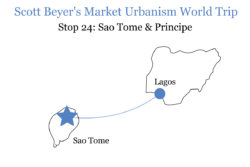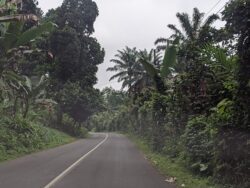The Challenge Of Being An Island Nation
Sao Tome knows the logistical hurdles of being small and remote. Can economic liberalization improve things?
This June I visited Sao Tome and Principe, a country about 200 miles off the coast of Gabon. It’s a tropical island with lots of built character and native vegetation, but people there go without access to many things that continental Africans enjoy. This is due to the logistical challenges of being small and remote, and raises the question of whether economic liberalization could improve things.
Sao Tome and Principe is an archipelago with two main islands. The larger one is Sao Tome, the smaller one Principe. Together they make up the second-smallest country in Africa, with a population of 220,000.
The island was uninhabited until Portuguese explorers found it in 1470. They used the island as a hub for the Atlantic slave trade. They also built plantations and used slave labor to grow sugar, coffee, and cocoa.
Sao Tome gained independence in 1975. Today it’s a very poor nation, with the majority-black population living on about $3,300 annually.

Visiting made me wonder what it would be like to live there. Sao Tome is far from its colonizing country, Portugal, but still feels like a colony. Portuguese is the official language, Catholicism is the major religion, and its major trade partners are European countries. But now an independent nation far off the coast, it’s mostly left alone.
One of the problems with being a remote island is that certain things are expensive (or unavailable), since the island must import most things.
When I visited, there was a major gas shortage. This caused hoarders to sell gasoline along roadsides at double the price.
Sao Tome is located in the oil-rich Gulf of Guinea, which produces 4.5 million barrels of oil daily and is estimated to contain 4.5% of the world’s reserves. But there is no oil production in Sao Tome. Instead, drilling is being explored offshore.
“Petro-piracy” is a big problem in the gulf. Sao Tome is an ideal location for piracy, since poverty in the area is high and the gulf is not well guarded without a strong navy. However, a United Nations report notes that piracy is on the decline, with 123 cases in 2020 and 45 in 2021. Many pirates have shifted to illegal bunkering, which is stealing oil directly from pipelines. Piracy increases the cost of goods and makes it harder for businesses to operate in the gulf since they must buy more expensive insurance.
But the main reason for Sao Tome’s gas shortage is debt. The country owes $270 million to Angola, through the state-owned oil company Sonangol. In response, the company has reduced supply to the island. Sao Tome needs fuel to run generators for electricity, so the lack of gas leads to blackouts.
Agriculture is the main industry in Sao Tome, but it’s not used to grow staple food items. 90% of food is imported, mainly rice, wheat, beans and maize. Mostly, locals grow cocoa. The islands were once so famous for this that they were called the “chocolate islands,” and cocoa still makes up 79% of exports. Sao Tome also exports pepper, coconut oil, and coffee.
All these exports are turned into high-profit items overseas. One way Sao Tome could improve its economy is by manufacturing and processing them itself, but that doesn’t happen due to limited industrial capacity, says local businessman Me-Chinho Costa Alegre.
Other native foods—such as the delicious Safou vegetable and the breadfruit—do not make it off the island for the same reason, he explains.

Fishing is also big in Sao Tome, a staple in the local diet. Fishing villages dot the coastline and about 16,000-20,000 people are employed in the industry. But fishing rights in West Africa are valuable, so the country sold that to the European Union for $854,722 annually over 5 years.
Due to lack of industrial farming, there is not much affordable meat available in markets or restaurants beyond what is caught at sea.
I’m one of the rare people who has actually gone to Sao Tome. According to the United Nations World Tourism Organization, it is among the least-visited countries on earth, attracting 34,900 visitors in 2019. The country wants to change that by promoting high-end eco-tourism within its untouched rainforests, but that will be tough given it has a small airport with expensive, sporadic flight connections.

Within Sao Tome there were limited stores, restaurants and amenities (I could not even find a gym) and portions of its beautiful seaside malecon had become sinkholes.
Innate to Sao Tome’s logistical and infrastructure problems is lack of economies of scale. There is minimal land, population and money to support sophisticated enterprise. This means under-optimization of resources, weaker trade partnerships, fewer jobs and lower living standards.
This is a common problem even on more populated island nations. I wrote in June about how Madagascar’s remoteness was a factor in making it among the world’s poorest countries.
But these countries can help reverse their natural disadvantage by opening to outside investors. The growing private city movement, for example, has targeted islands because they are less likely to attract interference from outside governments. One promise of these cities is to uplift island natives. The famous libertarian project Prospera is located in Roatan, Honduras, while lesser-known ones are being attempted throughout the Caribbean and, for that matter, Sao Tome.
Mauritius, an even more remote African island, is another blueprint. It was the first African country to form a special economic zone, in 1970, creating an exporting advantage for its robust sugarcane crop. It also became a tax haven, attracting companies from elsewhere in Africa. Mauritius now has a per-capita income of $22,000, and its fast-growing economy draws 1.3 million per year.
Sao Tome, Madagascar, and other poor island countries can look to Mauritius as a model for modernization.
All images credited to Scott Beyer and The Market Urbanist.
Catalyst articles by Scott Beyer | Full Biography and Publications
